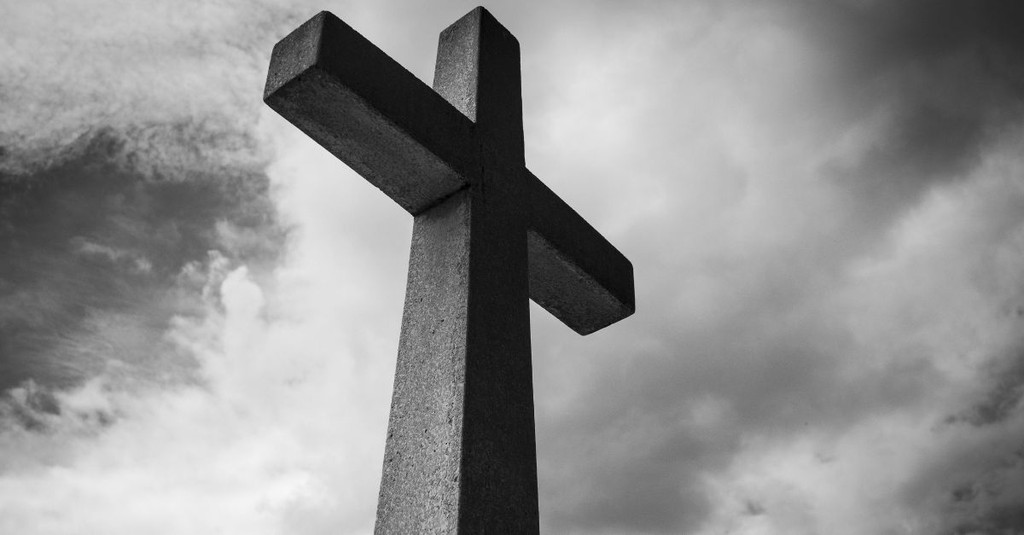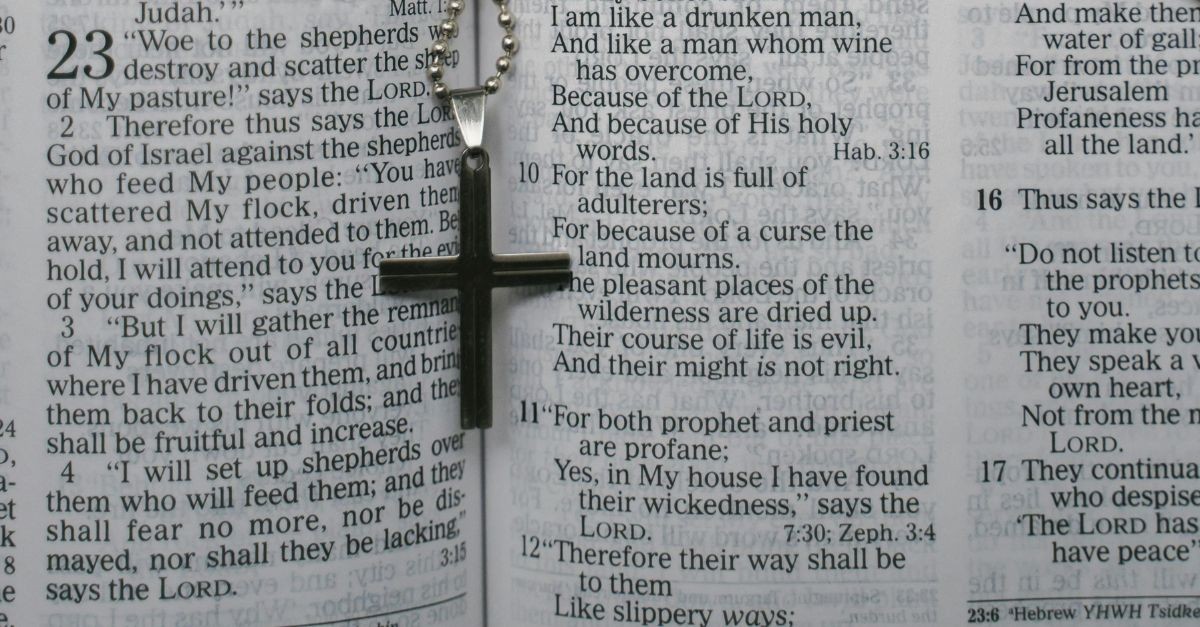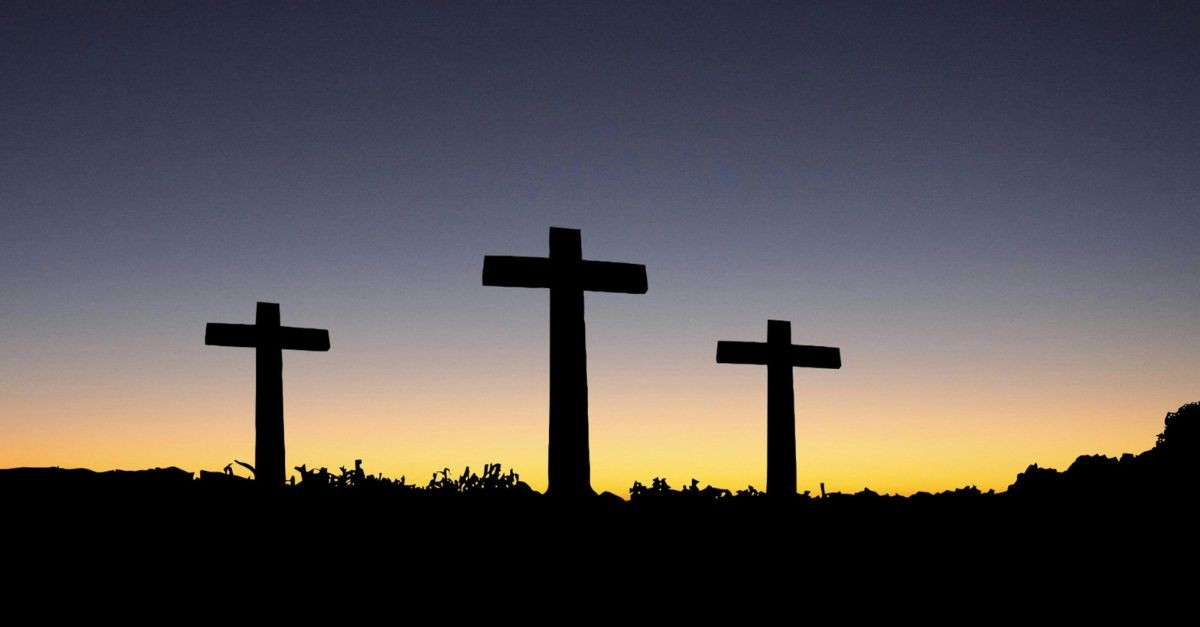
Christ on the cross. This image, which many call the crucifix, decorates churches and households, especially in Catholic traditions. Among more Evangelical persuasions, the cross is bare, symbolizing victory over death.
As much as the cross is a Christian symbol, it also happened in history. Jesus was a real, human person, and he was crucified two thousand years ago. This historical event happened in time but had eternal repercussions. On the cross, Jesus suffered deep pain for hours while being nailed to those pieces of wood.
But how long did Jesus hang on the cross?
Photo Credit: ©Pixabay

What was Important About the Cross?
In the Roman Empire, crucifixion was a method of execution reserved for the most despised criminals, slaves, and enemies of the state. Its purpose extended beyond mere punishment; it was designed to be a public spectacle, a deterrent against rebellion, and a means of asserting Roman authority and power. The excruciating agony and prolonged suffering inflicted upon the victim served as a stark reminder of the consequences of defying Roman rule.
Jesus, as the King of Kings and all creation, held supreme authority, and in a way, his existence did challenge the rule of any worldly authority, whether an oppressive empire, religious organization, or the human heart. This was a human, historical, and spiritual statement. Further, Jesus Christ, the Son of God, willingly endured crucifixion as the ultimate act of love and sacrifice. His death on the cross served as a redemptive atonement for humanity’s sins, reconciling people with God and offering salvation to all who believe in Him.
The Old Testament provides a prophetic foundation for understanding the cross. Deuteronomy 21:22-23 emphasizes the shame and curse of hanging on a tree or a cross, stating, “And if a man has committed a crime punishable by death and he is put to death, and you hang him on a tree, his body shall not remain all night on the tree, but you shall bury him the same day, for a hanged man is cursed by God.” Paul, in his letter to the Galatians, draws upon this Old Testament imagery to describe the significance of the cross. “Christ redeemed us from the curse of the law by becoming a curse for us—for it is written, ‘Cursed is everyone who is hanged on a tree’” (Galatians 3:13). In willingly bearing the curse of sin and its consequences on the cross, Jesus Christ provided a way for humanity to be set free from the bondage of sin and death.
Moreover, the cross serves as a symbol of hope and reconciliation, representing the triumph of life over death, love over hatred, and forgiveness over condemnation. It is through the cross that believers are invited into a restored relationship with God, empowered to live lives transformed by grace and guided by the example of Christ's sacrificial love.
Photo Credit: ©Pexels/Michael Morse

What is the Biblical Narrative About the Cross?
The Gospels provide a detailed account of the events leading up to Jesus' crucifixion, the crucifixion itself, and its aftermath.
In the Gospel of Matthew, the narrative begins with Jesus’ betrayal by Judas Iscariot in the Garden of Gethsemane (Matthew 26:47-56). Jesus is arrested by the temple guards and brought before the high priest and the Sanhedrin, where false witnesses testify against him (Matthew 26:57-68). Ultimately, Jesus is condemned to death for blasphemy by claiming to be the Son of God (Matthew 26:63-66).
Following his condemnation, Jesus is handed over to the Roman governor, Pontius Pilate, who finds no guilt in him but yields to the demands of the crowd and orders his crucifixion (Matthew 27:11-26). Jesus is then mocked, beaten, and scourged by the Roman soldiers (Matthew 27:27-31).
Carrying his cross, Jesus is led to Golgotha, where he is crucified alongside two criminals (Matthew 27:32-44). Despite the mockery and taunts from bystanders, Jesus maintains his composure, uttering words of forgiveness and compassion, including his famous cry, “My God, my God, why have you forsaken me?” (Matthew 27:46).
As Jesus hangs on the cross, darkness falls over the land, symbolizing the weight of sin and the separation from God that Jesus experiences on behalf of humanity (Matthew 27:45). In his final moments, Jesus cries out, “It is finished,” signaling the completion of his redemptive work (John 19:30).
Following his death, Jesus’ body is taken down from the cross and placed in a tomb, fulfilling the prophecy of Isaiah 53:9, which states, “And they made his grave with the wicked and with a rich man in his death.” However, on the third day, Jesus rises from the dead, triumphing over sin and death and offering the promise of eternal life to all who believe in him (Matthew 28:1-10).
Photo Credit: ©Pexels/Tima Miroshnichenko

What are Different Ideas of How Long Jesus Hung on the Cross?
While the Gospel accounts provide some details, there is no explicit mention of the exact length of time Jesus spent on the cross. As a result, scholars have examined different clues and perspectives to offer insights into this aspect of the crucifixion narrative.
One prevalent interpretation is that Jesus was crucified on the day of preparation for the Sabbath, which began at sundown on Friday. This view aligns with the Gospel narratives, which describe Jesus being crucified in the morning (Mark 15:25) and his body being taken down from the cross before sundown to avoid violating the Sabbath (John 19:31). Based on this timeline, some scholars argue that Jesus likely hung on the cross for approximately six hours, from around 9 AM to 3 PM.
However, other scholars suggest that the duration of Jesus’ crucifixion may have been shorter or longer than six hours. Some argue that the Roman practice of crucifixion typically resulted in a prolonged and agonizing death, with some victims lingering on the cross for several days before succumbing to exhaustion, dehydration, or asphyxiation. This perspective raises questions about the plausibility of Jesus dying after only a few hours on the cross.
On the contrary, some scholars contend that Jesus’ crucifixion may have been relatively brief due to the severity of his injuries, the brutality of the Roman soldiers, and the psychological and emotional stress He endured leading up to His death. They suggest that the intensity of Jesus’ suffering, coupled with divine intervention or supernatural factors, could have hastened His death, resulting in a shorter duration on the cross.
Additionally, biblical scholars examine theological symbolism and typology in their interpretations of the crucifixion narrative. Some draw parallels between Jesus' sacrifice and the sacrificial rituals of the Old Testament, noting that the Passover lamb, which prefigured Christ, was typically slaughtered in the afternoon of the 14th day of Nisan (Exodus 12:6). From this perspective, the timing of Jesus’ death aligns with the Passover observance, highlighting its significance as the ultimate atonement for sin.

Can We Know for Sure How Long Jesus Hung on the Cross?
The Gospel narratives provide significant details about the events leading up to Jesus' crucifixion, the crucifixion itself, and its aftermath, but they do not explicitly state the precise length of time Jesus spent on the cross. As a result, biblical scholars and theologians have offered various interpretations and conjectures based on the available evidence and historical context.
Interpreting the duration of Jesus’ crucifixion involves considering factors such as the Roman practice of crucifixion, the severity of Jesus’ injuries, and the theological significance of the event. Also, theological symbolism and typology play a role in interpreting the duration of Jesus’ crucifixion. Some scholars draw parallels between Jesus' sacrifice and the Passover lamb, which was slaughtered in the afternoon of the 14th day of Nisan (Exodus 12:6). From this perspective, the timing of Jesus’ death aligns with the Passover observance, emphasizing its significance as the ultimate atonement for sin.
The best interpretation of how long Christ hung on the cross continues to be based on the general Gospel timeline for Jesus’ crucifixion, from the third hour (9 am) to the late afternoon. Since darkness covered the land from the sixth hour to the ninth hour (12-3 pm), then at least those six hours. Finally, Jesus cried out with a loud voice and breathed his last, indicating his death. We know, from Jewish religious law, that they had to remove him from the cross before sundown, which would have included preparing the body and placing him in the tomb. This could have been from 3 pm to 5 pm, a range of 6-9 hours.
Photo Credit: ©Pexels/David Dibert

What Does Jesus on the Cross Mean for Us Today?
First, the crucifixion of Jesus represents the pinnacle of God’s plan for salvation and reconciliation with humanity. Jesus willingly endured the agony and shame of the cross as a sacrificial offering for the forgiveness of sins. his death on the cross serves as the atoning sacrifice that bridges the gap between our brokenness and God’s holiness, paving the way for restoration and redemption.
The cross exemplifies the depth of God’s love and the extent to which he is willing to go to reconcile us to Himself. Paul writes in Romans 5:8,
“But God demonstrates his own love for us in this: While we were still sinners, Christ died for us.”
The cross is a tangible demonstration of God’s unconditional love and grace, offering forgiveness, mercy, and reconciliation to all who believe in the Lord Jesus Christ.
Moreover, the cross serves as a powerful symbol of hope and transformation. Through Jesus’ death and resurrection, we are promised new life, freedom from the power of sin, and the hope of eternal salvation. Again, Paul affirms in Galatians 2:20:
“I have been crucified with Christ, and I no longer live, but Christ lives in me. The life I now live in the body, I live by faith in the Son of God, who loved me and gave himself for me.”
Additionally, as we are followers and disciples of Christ, the cross challenges us to embrace a life of sacrificial love and selflessness. Christ didn’t die on the cross so we would never have to experience our own cross. On the contrary, he paved the way, showing us how personal self-sacrificial love for others is the way. Jesus’ command to take up our cross and follow him (Matthew 16:24) calls us to embody the same spirit of humility, compassion, and service that Jesus exemplified on the cross. And as Jesus did this willingly, no one taking his life from him but giving it out of love, we are called to do the same (John 10:18).
To specifically look at the amount of time Jesus hung on the cross, we learn that this sacrifice happens over time. We must endure through life hardships and continual sacrifice for the redemption of others (Matthew 24:13). As Jesus called out upon the cross, giving his life up to the Father, we willingly chose to do the same daily.
Just as the Father rewarded Jesus for his sacrifice, a name above all names (Philippians 2:9-11), God rewards us, as well in both this life and the life to come. And as Peter says, those glorious rewards far outweigh any suffering now (1 Peter 4:13).
Photo Credit: ©Pexels/cottonbro studio

Originally published Friday, 01 March 2024.
